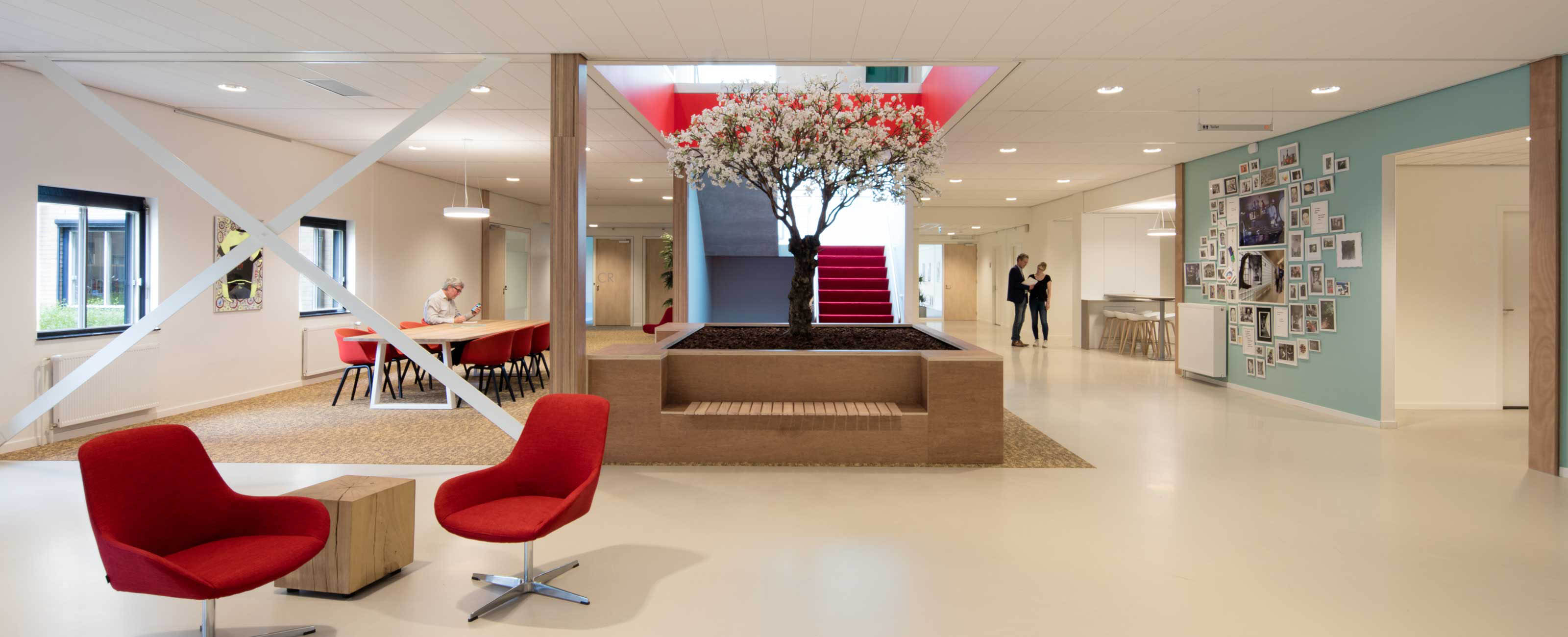Repurposing vacant real estate: former outpatient clinic transformed into modern office space
In the centre of Tilburg, a former outpatient clinic belonging to GGz Breburg has been transformed into an open office space, designed to foster interaction, collaboration, and knowledge sharing. Smart interventions have created a clear and spacious structure, offering visibility, natural light, and comfort.
EGM Architects designed the interior for the transformation of the former outpatient clinic into office space for management and support services, while the restaurant has also been converted into a welcoming work café.
Healthcare is shifting towards home
Mental healthcare in the Netherlands is undergoing a transition: care is moving towards home. The government aims to enable people to live independently in their own environment for as long as possible. GGz Breburg, a specialist mental healthcare institution, is responding to this shift by improving outpatient care and reducing the number of clinical admissions. As a result, vacant spaces within the organisation have been repurposed for its own support services. One such building is the former polyclinic in the centre of Tilburg. EGM architects designed the interior for its transformation into office space for the board and support services, also converting the restaurant into a welcoming work café.
Natural light, spaciousness, and comfort
The interior design concept is centred on transforming a dark, austere, and monotonous environment into a bright, comfortable, and varied office space. This has been realised through an efficient, open-plan workspace with ample natural light and clear sightlines. Flexible workstations ensure optimal use of space, while activity-based work areas encourage knowledge sharing, interaction, and collaboration. Acoustic panels, air and temperature regulation, and artificial lighting further enhance comfort.
From a closed outpatient clinic to an open office space
The building comprises four interconnected sections, each with its own structure. By removing walls, adjusting the layout, and adding skylights, natural light now penetrates deep into the building. A void near the entrance and the integration of visual art enhance the sense of spaciousness. Varying ceiling heights and different floor colours distinguish work areas from circulation zones. Differences in wall heights, glass partitions, and workplace types add variety. With a simple yet effective intervention, the entrance façade has been made more inviting and recognisable, aligning with the identity of GGz Breburg: resilient, welcoming, and forward-thinking.
This transformation presents a fantastic opportunity to convert dark, closed-off buildings into open and bright workspaces, which also leads to significant cost savings for the client
Sustainability and flexibility
By improving the spatial and physical quality of the building, its lifespan has been extended. Other sustainable measures include the reuse of furniture, the application of Cradle-to-Cradle materials, the use of LED lighting, and the retention of existing, resource-intensive elements. The open-plan structure with flexible workstations also allows for the creation of additional workspaces in the future.
In early 2021, GGz Breburg received the ‘Green Deal Healthcare’ sustainability certificate. The goal of the Green Deal is to enhance the environmental performance of existing healthcare institutions and extend these improvements to potential new locations.
Evidence-Based Design
Great attention has been paid to environmental factors such as light, air, temperature, and sound. To assess the light output of the skylights, simulation models were developed. These demonstrated that even without skylights, the building would meet office space requirements. However, as natural light significantly contributes to well-being and regulates the biological clock, a deliberate decision was made — in close consultation — to include skylights in the design.
The choice of artificial lighting was also carefully considered. To determine the most suitable warmth for the artificial lighting, a trial was conducted in three identical office spaces. Using simple questionnaires and direct feedback, employees’ responses were gathered and incorporated into the design.
Meeting user needs
During the design process, EGM, together with the project management agency, organised regular workshops with the client, GGz Breburg. A ‘Brown Paper session’ was used to collect and visualise input from different users. This approach ensured that EGM’s design aligned functionality, comfort, and aesthetics with the diverse needs of the users. The result is a well-balanced, open, inviting, and flexible design—an exciting challenge successfully realised through close collaboration and user engagement.
Photography: Jeroen Musch







